
- Home Page
- Accepted
Paintings & Copies - Doubtful
Attributions - Doubtful Textual References
- Alternative
Titles - Collectors &
Museums - Bibliography
- Search Abecedario
- Watteau &
His Circle
Du Bel âge
Entered August 2020; revised September 2020

Presumed lost
Oil on panel
21.6 x 29.7 cm
ALTERNATIVE TITLES
Le Concert
Un Concert dans un appartement
Les Jeux remplissent vos desirs
Musica a quattro
RELATED PRINTS
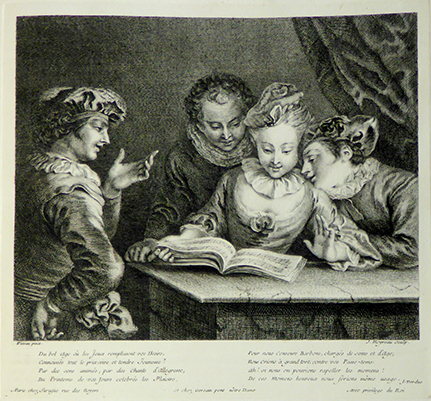
Jean Moyreau’s print after Watteau’s Du Bel âge was announced for sale in the June 1728 issue of the Mercure (p. 1433), where it was referred to as “un Concert.”
SELECT BIBLIOGRAPHY
Mariette, “Notes manuscrites,” 9: fol. 191.
Hédouin, “Watteau” (1845), cat. 29.
Hédouin, “Watteau” (1856), cat. 29.
Goncourt, L’Art au XVIIIème siècle (1860), 58.
Goncourt, Catalogue raisonné (1875), cat. 1875.
Dacier, Vuaflart, and Hérold, Jean de Jullienne et les graveurs (1921-29), 2: 28, 57, 133; 3: cat. 94.
Réau, “Watteau” (1928), cat. 140.
Adhémar, Watteau (1950), cat. 84.
Mathey, Watteau, peintures réapparues (1959), 66.
Macchia and Montagni, L’opera completa di Watteau (1968), cat. 58.
Roland Michel, Watteau (1981), cat. 119.
Roland Michel, Watteau (1984), 217
Posner, Watteau (1984), 258, 290 nn. 53, 54.
Washington, Paris, Berlin, Watteau 1684-1721 (1984), under cat. 29.
RELATED DRAWINGS
None of Watteau’s drawings have been directly associated with Du Bel âge.
REMARKS
The whereabouts and fate of Du Bel âge after it was engraved are entirely unknown. Dacier, Vuaflart, and Hérold proposed that it was perhaps the painting given to Watteau that was sold in Paris from the comte de Caissotti’s collection on February 15, 1850, lot 49: “Pierrot, Colombine et Arlequin, six figures à mi-corps. Composition aussi gravée.” But as this painting had six figures, whereas Du Bel âge had only four, the Caissotti painting must have been a different composition.
Scholars have agreed that this painting comes from the early portion of Watteau’s career. Mathey assigned it to c. 1704-05, which would represent his earliest moments. Macchia and Montagni preferred c. 1710. Adhémar chose 1712, Posner suggested 1712 or still later, while Roland Michel allowed for both 1712-14 and 1714-15. If Mathey erred in trying to place this painting as early as 1704-05, a period in Watteau’s career for which there is paltry information, so too Roland Michel’s leaning to 1714-15 is surprisingly late because the painting is by no means as fluent and mature as it should be for this phase in the artist’s development.
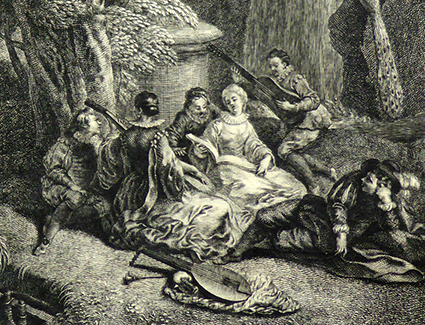
Jean Moyreau after Watteau, L’été (detail), from the Saisons Jullienne, engraving.
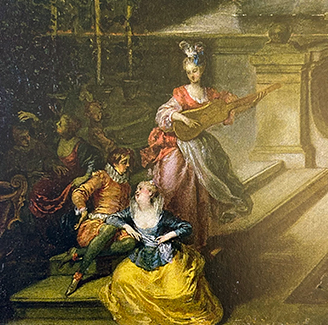
Antoine Watteau, Le Printemps (detail), from the Saisons Jullienne, oil on canvas. Whereabouts unknown.
If one were to place Du Bel âge within the context of Watteau’s established oeuvre, comparisons with the figures in the series of Four Seasons owned by Jean de Jullienne are useful. The figures in both have the same proportions and awkward, mannered gestures. The problem, of course, is that there is no agreement as to when the Saisons Jullienne were executed. Some would date the series to c. 1710 but that, alas, is just another arbitrary assessment.
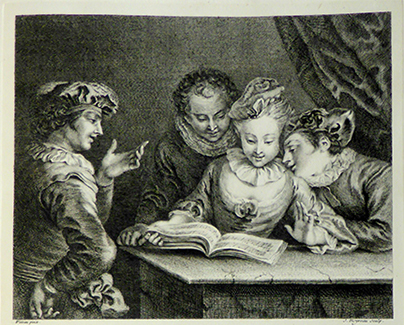
Jean Moyreau after Watteau, Du Bel äge, 1728, engraving.
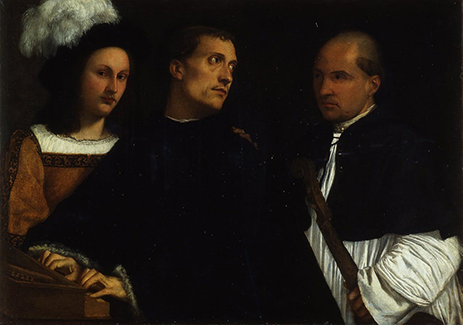
Giorgione or Titian, The Concert, oil on canvas, Florence, Uffizi.
The compositional format of Du Bel âge—half-length figures compressed into a narrow space—was popular in the Renaissance and can be compared to the Uffizi’s The Concert, a work whose attribution over the centuries has gone back and forth between Giorgione and Titian. It was these two artists who were cited when a painting with half-length musicians, and attributed to Watteau, came up at auction in the nineteenth century. Whether that work, Cinq personnages occupés à faire de la musique, was actually by Watteau or one of his followers, and whether it was based on Venetian or Northern models, reminds us, as is clearly demonstrated by Du Bel âge, that Watteau was working in an established mode and how, especially in his early years, he recognized the authority of the past.